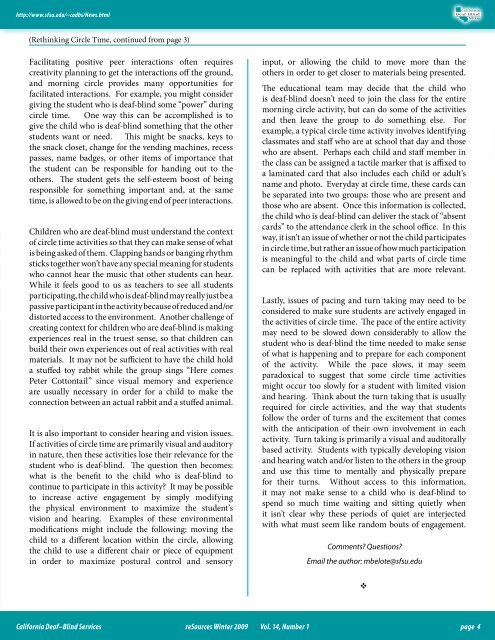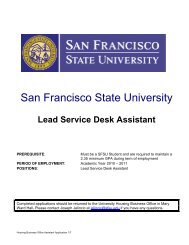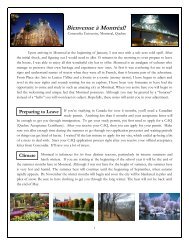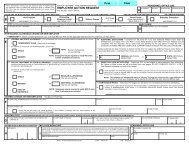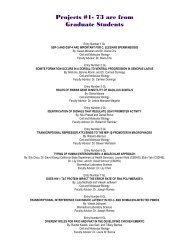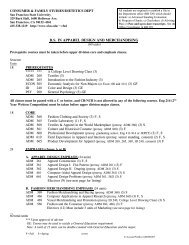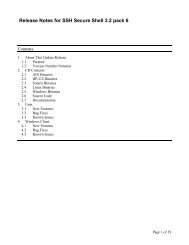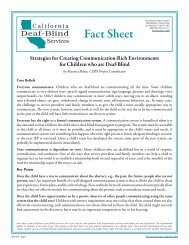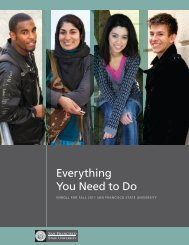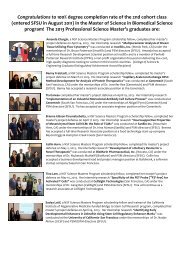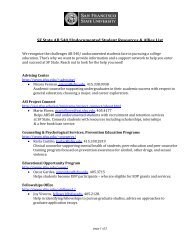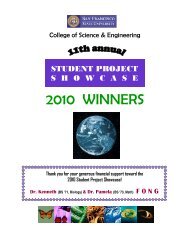reSources Spring 2008 (Vol. 13, No. 2) - San Francisco State ...
reSources Spring 2008 (Vol. 13, No. 2) - San Francisco State ...
reSources Spring 2008 (Vol. 13, No. 2) - San Francisco State ...
You also want an ePaper? Increase the reach of your titles
YUMPU automatically turns print PDFs into web optimized ePapers that Google loves.
http://www.sfsu.edu/~cadbs/News.html<br />
California<br />
Deaf-Blind<br />
Services<br />
(Rethinking Circle Time, continued from page 3)<br />
Facilitating positive peer interactions often requires<br />
creativity planning to get the interactions off the ground,<br />
and morning circle provides many opportunities for<br />
facilitated interactions. For example, you might consider<br />
giving the student who is deaf-blind some “power” during<br />
circle time. One way this can be accomplished is to<br />
give the child who is deaf-blind something that the other<br />
students want or need. This might be snacks, keys to<br />
the snack closet, change for the vending machines, recess<br />
passes, name badges, or other items of importance that<br />
the student can be responsible for handing out to the<br />
others. The student gets the self-esteem boost of being<br />
responsible for something important and, at the same<br />
time, is allowed to be on the giving end of peer interactions.<br />
Children who are deaf-blind must understand the context<br />
of circle time activities so that they can make sense of what<br />
is being asked of them. Clapping hands or banging rhythm<br />
sticks together won’t have any special meaning for students<br />
who cannot hear the music that other students can hear.<br />
While it feels good to us as teachers to see all students<br />
participating, the child who is deaf-blind may really just be a<br />
passive participant in the activity because of reduced and/or<br />
distorted access to the environment. Another challenge of<br />
creating context for children who are deaf-blind is making<br />
experiences real in the truest sense, so that children can<br />
build their own experiences out of real activities with real<br />
materials. It may not be sufficient to have the child hold<br />
a stuffed toy rabbit while the group sings “Here comes<br />
Peter Cottontail” since visual memory and experience<br />
are usually necessary in order for a child to make the<br />
connection between an actual rabbit and a stuffed animal.<br />
It is also important to consider hearing and vision issues.<br />
If activities of circle time are primarily visual and auditory<br />
in nature, then these activities lose their relevance for the<br />
student who is deaf-blind. The question then becomes:<br />
what is the benefit to the child who is deaf-blind to<br />
continue to participate in this activity? It may be possible<br />
to increase active engagement by simply modifying<br />
the physical environment to maximize the student’s<br />
vision and hearing. Examples of these environmental<br />
modifications might include the following: moving the<br />
child to a different location within the circle, allowing<br />
the child to use a different chair or piece of equipment<br />
in order to maximize postural control and sensory<br />
input, or allowing the child to move more than the<br />
others in order to get closer to materials being presented.<br />
The educational team may decide that the child who<br />
is deaf-blind doesn’t need to join the class for the entire<br />
morning circle activity, but can do some of the activities<br />
and then leave the group to do something else. For<br />
example, a typical circle time activity involves identifying<br />
classmates and staff who are at school that day and those<br />
who are absent. Perhaps each child and staff member in<br />
the class can be assigned a tactile marker that is affixed to<br />
a laminated card that also includes each child or adult’s<br />
name and photo. Everyday at circle time, these cards can<br />
be separated into two groups: those who are present and<br />
those who are absent. Once this information is collected,<br />
the child who is deaf-blind can deliver the stack of “absent<br />
cards” to the attendance clerk in the school office. In this<br />
way, it isn’t an issue of whether or not the child participates<br />
in circle time, but rather an issue of how much participation<br />
is meaningful to the child and what parts of circle time<br />
can be replaced with activities that are more relevant.<br />
Lastly, issues of pacing and turn taking may need to be<br />
considered to make sure students are actively engaged in<br />
the activities of circle time. The pace of the entire activity<br />
may need to be slowed down considerably to allow the<br />
student who is deaf-blind the time needed to make sense<br />
of what is happening and to prepare for each component<br />
of the activity. While the pace slows, it may seem<br />
paradoxical to suggest that some circle time activities<br />
might occur too slowly for a student with limited vision<br />
and hearing. Think about the turn taking that is usually<br />
required for circle activities, and the way that students<br />
follow the order of turns and the excitement that comes<br />
with the anticipation of their own involvement in each<br />
activity. Turn taking is primarily a visual and auditorally<br />
based activity. Students with typically developing vision<br />
and hearing watch and/or listen to the others in the group<br />
and use this time to mentally and physically prepare<br />
for their turns. Without access to this information,<br />
it may not make sense to a child who is deaf-blind to<br />
spend so much time waiting and sitting quietly when<br />
it isn’t clear why these periods of quiet are interjected<br />
with what must seem like random bouts of engagement.<br />
Comments? Questions?<br />
Email the author: mbelote@sfsu.edu<br />
v<br />
California Deaf–Blind Services <strong>reSources</strong> Winter 2009 <strong>Vol</strong>. 14, Number 1 page 4


